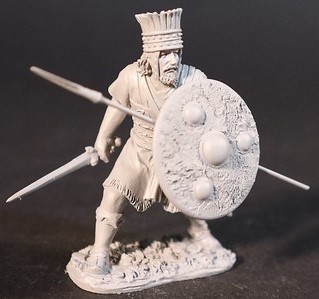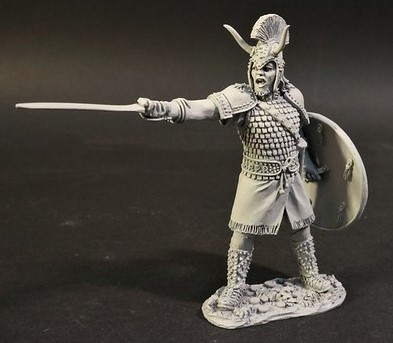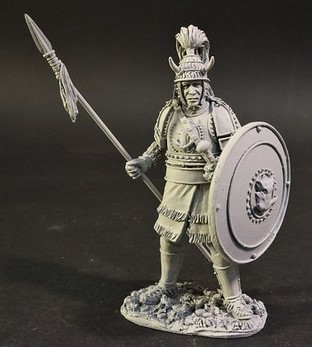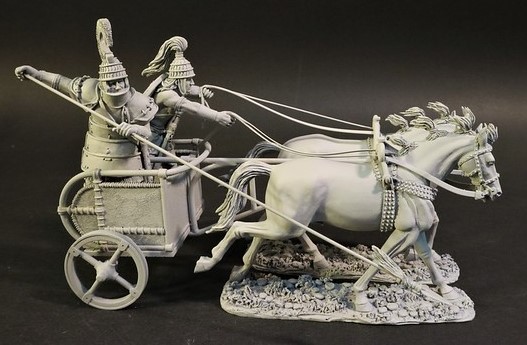Troy Prototypes (8 AUG )
 |
Update 8 AUG 22 The Trojan army defending the great city of Troy, led by their king Priam, had assistance from a long list of allies. These included the Lycians, which was a maritime district in south western Anatolia (now Turkey). It was situated along the Mediterranean coast between Caria and Pamphylia, and extended inland to the ridge of the Taurus Mountains.
SARPEDON
In the Iliad, Sarpedon scolded Hector, claiming that he left all the hard fighting to the allies of Troy and not to the Trojans themselves, and made a point of saying that the Lycians had no reason to fight the Greeks, or no real reason to hate them, but because he was a faithful ally to Troy he would do so and fight his best anyway. Glaucus, (colour figure in image above) the son of Hippolochos, accompanied Sarpedon (below) to Troy along with his troops from Xanthos. Himself a prominent warrior, Glaucus meets the Greek hero Diomedes on the battlefield, who is leading the Greek forces with the help of the goddess Athena. Glaucus and Diomedes exchange words and upon learning about each other's ancestry, the two warriors decide to not fight each other despite being on opposing sides. Coincidentally both their grandfathers shared a bond of friendship in the past. They continue the tradition of friendship by giving each other their own armour as a gift and part ways as friends.
TROY Update 26 MAR 22. The first of the Trojan War figures, should be available in December. The Trojan War will be a huge project, and of course all the main protagonists, will be produced, including Helen, Priam, and Aeneus, as well as most of the main allied contingents. Traditionally, the Trojan War arose from a sequence of events beginning with a quarrel between the goddesses Hera, Athena and Aphrodite. Eris the goddess of discord, was not invited to the wedding of Peleus and Thetis, and so arrived bearing a gift. A golden apple, inscribed “for the fairest”. Each of the goddesses claimed to be the “fairest”, and the rightful owner of the apple. They submitted the judgement to a shepherd they encountered tending his flock. Each of the goddesses promised the young man a boon in return for his favour. Power, wisdom, or love. The youth, in fact Paris, a Trojan prince who had been raised in the countryside, chose love, and awarded the apple to Aphrodite. Greek Infantry
Chariots In Homer’s Iliad, Pandarus is a renowned archer (in right chariot) and the son of Lycaon. He fought on the side of Troy in the Trojan War and led a contingent from Zeleia.
Deiphobus was a son of Priam and Hecuba. He was a prince of Troy, and the greatest of Priam’s sons after Hector and Paris. Deiphobus killed four men of fame in the Trojan War.
MENELAUS above
According to legend, in return for awarding her a golden apple inscribed “to the fairest”, Aphrodite promised Paris the most beautiful woman in all the world.
AGAMEMNON above
DIOMEDES above He and Odysseus were the only Achaean heroes who participated in covert military operations that demanded discipline, bravery, courage, cunning and resourcefulness. There will to be chariots!
Pandarus In Homer’s Iliad, Pandarus is a renowned archer and the son of Lycaon. He fought on the side of Troy in the Trojan War and led a contingent from Zeleia.
Glaucus Glaucus, the son of Hippolochos, accompanied Sarpedon to Troy along with his troops from Xanthos. Himself a prominent warrior, Glaucus meets the Greek hero Diomedes on the battlefield, who is leading the Greek forces with the help of the goddess Athena. Glaucus and Diomedes exchange words and upon learning about each other's ancestry, the two warriors decide to not fight each other despite being on opposing sides. Coincidentally both their grandfathers shared a bond of friendship in the past. They continue the tradition of friendship by giving each other their own armour as a gift and part ways as friends.
Trojan Archer There will be Trojan archers to defend the Walls of Troy.
TROY or ILION was an ancient city, known as the setting for the Greek myth of the Trojan War.
Until the late 19th century, modern scholars regarded the Trojan War as entirely fictional. In 1871, Heinrich Schliemann and Frank Calvert excavated the site believed to be Troy. Several layers excavated resembled the literary depictions of Troy, leading some scholars to conclude that there is a kernel of truth to the legends. Although Schliemann’s legacy remains controversial due to his excavation methods, which included dynamiting layers he considered insignificant.
The Scaean Gate
Straight wall section
The eastern or Dardanian Gateway
The eastern walls of Troy were reinforced by towers. One of these massive bastion at the north eastern corner was built to defend a well, which was one of the main water supplies, the other was to reinforce the city’s main entrance the Scaean Gate. The images below are drawing by John Jenkins showing his designs for future figures in this new series. Achilles
Myrmidon Warrior
Hector
Greek Warrior
Trojan Warrior
|






















